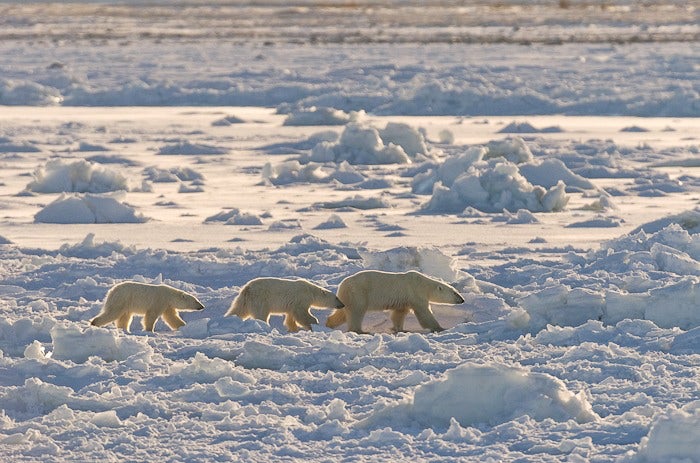
A late freeze-up on Hudson Bay delayed the return of the area’s polar bears to their seal-hunting grounds. The implications go far beyond polar bears and far beyond the Arctic.
With Christmas almost upon us, the polar bears of western Hudson Bay have finally returned to their sea-ice hunting grounds. The fall of 2016 was the latest freeze-up ever for these bears, shortening their seal-hunting season and straining the limits of their fat reserves.
During the first decade of the satellite record (1979-1989), western Hudson Bay had 30% ice coverage by November 13th. During the most recent decade, the average freeze-up date was pushed back to November 24th. But this year on November 24th, there was no ice anywhere in the bay, and polar bears could not return to the ice until the middle of December.
Polar bears can only reliably catch their seal prey from the surface of the sea ice. For them, no ice = no hunting = no food. This autumn as hungry polar bears waited longer for the ice to return to the area of Churchill, Manitoba—often called the polar bear capital of the world—reports of polar bear/human conflicts hit an all-time high. Numerous conflicts also were observed amongst the bears themselves as hungry bears tried to catch and eat each other.
Although freeze-up finally has arrived on Hudson Bay, the sea ice extent across the Arctic has remained at record lows since October. This means that Churchill’s polar bears are not the only ones at risk. From Alaska to Canada, from Greenland to Svalbard and across the Russian Arctic, the very existence of polar bears ultimately is threatened by sea ice loss from human-caused climate change.
If the bears are lucky, next year’s freeze-up may not be as late as this year’s due to natural variation in the climate system. But unless we halt CO2 concentration rise, years like 2016 are guaranteed to be increasingly frequent, and the average availability of sea ice that bears need for hunting can only decline until it is gone—with grave impacts for polar bears.
But should we really care about the polar bear’s problems? Is there value in preserving cold places like those on which polar bears depend? Despite having worked most of my adult life in the Arctic, even I don’t like being cold. So, should we really be concerned?
Yes, I think we should! Because polar bears depend on a habitat that literally melts as temperatures rise, they provide an easy-to-see example of the impacts of global warming. But global warming is indeed global, goes way beyond melting sea ice, and provides many reasons for concern.
Preventing ever-stronger waves of human refugees is one of those reasons. Around the world there is increasing angst about human refugee problems and mass migrations, as millions of people try to find better lives for themselves. Mass migrations and worsening refugee crises are assured if we allow Earth’s temperature to continue to increase.
Across Africa and the Middle East, for example, where warmer temperatures and drying landscapes already have challenged human welfare, annual average temperatures are projected to be 3-5°C (~5-9°F) warmer, by the end of the century, than at present. Three or even 5° may not sound like much, but we must remember this is the annual average! The impact of this “average temperature increase” on seasonal temperatures will be huge. If societies around the world continue to release CO2 at present rates, end-of-century summer temperatures over most of Africa and the Middle East will be hotter than anything we ever have experienced.
Some parts of the Middle East are predicted to see summer temperature extremes that humans simply cannot withstand. Water availability for wildlife, livestock, and people across much of this region will be dramatically reduced. Each ° C temperature rise, on average, is expected to reduce wheat production by 4%-6%, with impacts greater in areas that already experience warm growing conditions. On top of blistering heat and reduced agricultural production, human numbers across Africa and the Middle East are projected to increase 2-3 fold this century. It is clear that if we fail to halt global temperature rise, numbers of refugees challenging the world’s national boundaries, including our own, will exceed anything we currently can imagine. Polar bears are shouting a message now about how unbearable our world will be in the future if we don’t deal with this crisis, so yes, we should care.
Much of President-elect Trump’s support arose from concerns about managing human migration challenges. Mr. Trump knows that refugee crises must be solved at their source rather than at borders of countries to which people are fleeing. He also knows that action is required now to head off these future challenges. If we wait until that unbearable heat is upon us, humanitarian challenges literally will be unmanageable.
On the other hand, if we stop global temperature rise in time to save polar bears, we can assure a future world climate that will dramatically reduce humanitarian hardships and stop many refugee crises before they emerge.
Avoiding future refugee challenges is at least one reason we should care about polar bears. And in this season of giving and goodwill, we should thank polar bears for the message they are sending.
